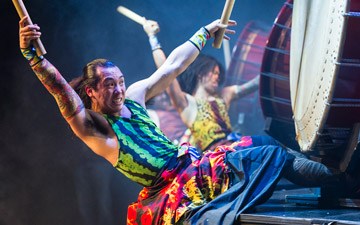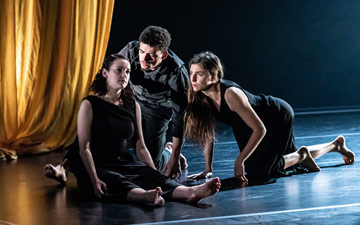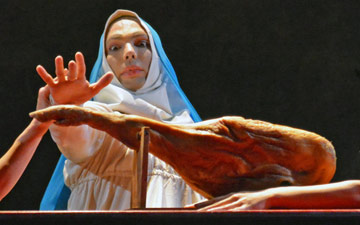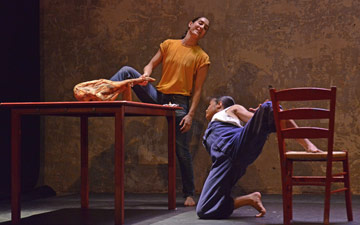
© Masa Ogawa. (Click image for larger version)
Yamato
Passion
★★★★✰
London, The Peacock
23 March 2019
yamatodrummers.com
I love shows like this. The performances that one wanders into reluctantly, wondering about all the other things on life’s to-do list that would be better served by these precious few hours than watching a show about drumming; but it turns out to be such an uplifting, electrifying experience that the to-do list is mentally shredded and I left the theatre with a rhythmic bounce and not a care in the world. So, heartfelt thanks go to these drummers of Japan for giving me such a tremendous, and unexpected, buzz.
The Taiko drumming is pure, tightly co-ordinated rhythmic energy, controlled by the beat and accented by the boom. There are so many different types of drum in use for this performance, ranging in size from portable beasts slung, military-style, around the body to be beaten at waist level; to the largest drum I’ve ever seen. Made from the trunk of a 400-year old tree, this wadaiko (Japanese drum) is big enough to live inside and is beaten by two enormous clubs wielded like weapons by one extremely powerful man.
There is also a trio of women in the mix, accompanying the power of the drums with the lyricism of the flute and the shamisen (a three-stringed, long-necked, plucked instrument, with a body the size of a banjo but looks similar to a drum). These women also beat drums with an athleticism and muscularity no less notable than the men. The Yamato performers are said to begin every day with a communal 10km run and it is easy to believe.
The eight core musical numbers each drew from aspects of Japanese culture and geography, utilising this eclectic array of drums, which – mounted at different levels on the stage – also formed the set with the performers often operating at three different height levels. It was all impressive but the most notable routine was a group of four drummers on the upper tier, bare backs, glistening with sweat, turned to the audience; lying prone and unsupported, stretched out into the air, drum clubs in each hand. From this position, they proceeded to perform the drummers’ equivalent of two hundred sit-ups, levered upwards by their feet hooked into the apparatus, holding the position at different angles to the drums; and yet still playing these enormous wadaikos in perfect harmony. It was the most incredible demonstration of Olympian core body strength; beyond Olympian, because I cannot imagine any sport requiring this intense physicality over such a sustained period. These guys must have stomachs as taught as the drum skins they were beating!
The sound of many drums, however expertly co-ordinated and varied, is a difficult product with which to sustain a whole two-hour show on its own and so Passion is punctuated by some comic interludes, led by the ever-smiling Kenta Ono – resplendent in a Mohican hairstyle – with other men taking it in turns to be his hapless foil or adversary, in mock competition with one another, beating out repetitive time signatures and inviting the audience to participate. It could have all fallen flat but the audience had been so warmed-up by the incessant rhythms and ebullient charm of these performers that they readily joined-in and with gusto.
While taiko drumming is the primary ingredient of Passion, choreographed and co-ordinated movement is also key. The drummers perform with their whole bodies, striking with power and intensity but also with charm, grace and rhythm. Wherever there is beat, there is dance; and the excitement translated easily from stage to stalls, with a palpable surge of energy and movement led by the performers and undulating throughout the audience. The Yamato ensemble was founded, in 1993, by Masa Ogawa who remains at the heart of the company’s artistic vision; composing, choreographing and designing every show.
Although Yamato is now a global brand, touring for up to ten months each year – having performed in 54 countries since it was formed – the drummers are all based in a village called Asuka, in the Nara prefecture of Southern Japan. It is a place of special historical interest where ancient palaces, temples and tombs can be found, including Japan’s oldest Buddhist shrine. Today it hosts less than 6,000 inhabitants; some of whom, it would appear, are super-human.

















You must be logged in to post a comment.